The Pallottine missionaries arrived in Poland on February 2nd, 1934. This was at the initiation of Fr. Alojzy Majewski, Pallottine missionary in Cameroon. Twenty seven years before he had transferred the Association of Pallottine Priests and Brothers from Italy to Poland.
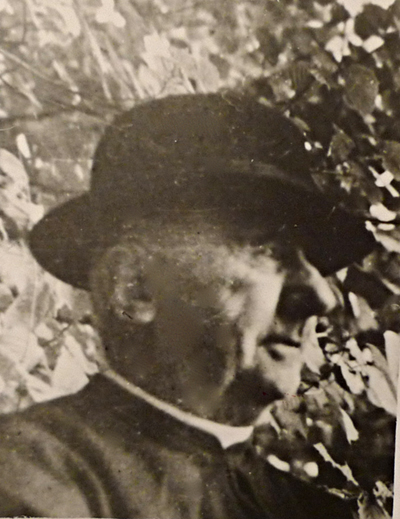
Fr. Alojzy Majewski, SAC – Rajca 1935
The first sisters: Srs. Leona Schettke, Meinolfa Falk, Maura Brener, Norberta Kempkes, Berthilla Neguin , as well as Srs. Aurelia Wachowska* (photo – left) and Sr. Kazimiera Milewska** (photo – right), of Polish origin, came from Limburg, Germany, and accepted the hospitality of the Pallottine Priests in Oltarzew. Benefitting from their spiritual and material care, the Sisters prepared themselves for the tasks awaiting them. The ideas of Vincent Pallotti had become widely known in society as a result of the apostolic activities of the Pallottine Fathers, and in a short time candidates interested in the missions appeared at the door. Upon their departure from Oltarzew, there were up to seven. From there, the pioneer track of Pallottines ran to the northeast, to Rajca, near the town of Nowogrodek (today it belongs to Belorussia). On April 12th, 1934, the Sisters took over from the Pallottine Fathers the manor-house and 60-acre farm that had belonged to the Counts Wereszczak.

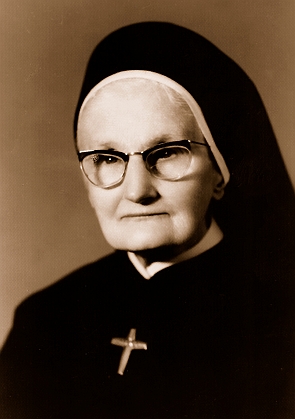
Sr. Aurelia Wachowska and Sr. Kazimiera Milewska
The first two years unfolded to Sisters under the sign of a triple blessing: sacrifice, privation and hard work. Their eager and capable hands tackled worn buildings(sisters themselves performed the work of bricklayer and painter), teneded the farm and garden, and most importantly – served the poor local people. Thanks to the generosity of the society of central Poland, relatively soon the sisters managed to adapt an out-dated corn house to a worship space.
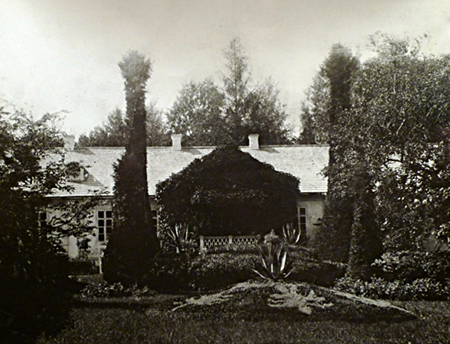
Our house in Rajca, 1934
The new chapel was welcomed by Catholics and Orthodox Christians, much more numerous. The people assembled there, both for Masses and services, and for para-liturgical solemnities, eg. occasional academies, mysteries, singing (in time the first Rajca church choir began under the direction of Sr. Bertilla). And though one did not yet speak of ecumenism, and one made no list of guidelines for this type of activity, systematically there grew a social and religious bond among the Christians at this recess of the eastern borders of the country.
As the sisterly community expanded (5 new candidates arrived from Limburg), widened also the range of so-called external works. The Sisters took care of the ill, opened a free nursery school and a club room in Rajca. Within the framework of evangelical works of the Church, they organized the Eucharistic Crusade and the Marian Sodality among the young people; they led the Catholic Action of Women; and of course they catechized. Since their localities, were scattered within a radius of dozen or so miles, the Sisters’ sense of canonical mission and apostolic zeal proved equally important as quasi-natural attributes. Even the parish retreat did not dispense Sisters who filled the time between conferences with saying their common prayers, spiritual readings and singing with parishioners. Even postulants were engaged in those actions, though indirectly. They helped out busier farm-housewives with household duties (cooked, baby-sat etc.), so that they could calmly attend the talks on recollection and prayer.
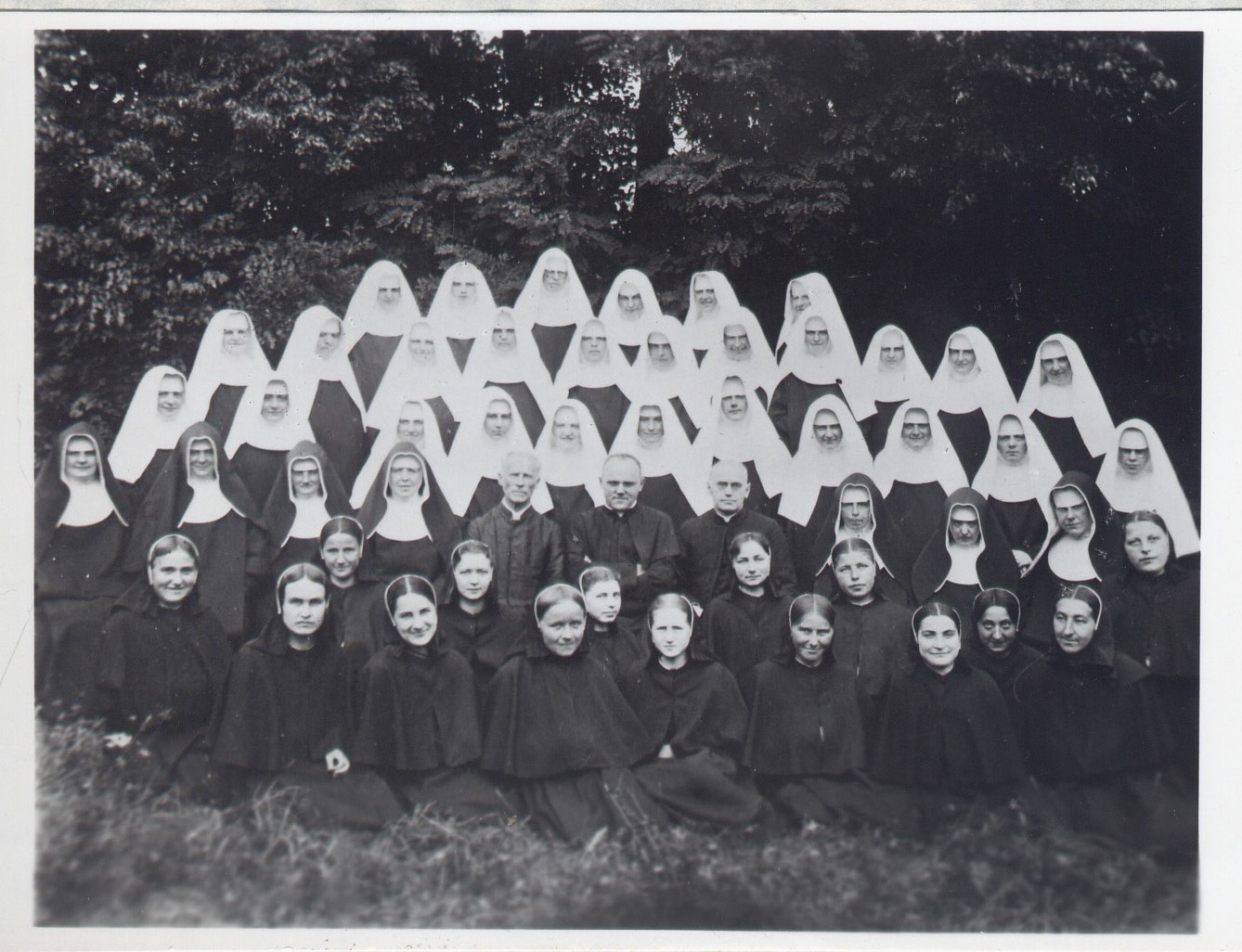
Rajca, 1935/36
This very young Congregation faced its first sizable venture in the year 1936. The Sisters of German origin did not receive renewal of their passports; consequently had to return home. The community of professed Sisters was reduced to two persons within half a year. Happily, on July 2nd, 1937, 13 novices made their first vows in the presence of the general superior Mother Aquina Klähr. The solemn liturgy was presided by Bishop Karol Niemira from Pinsk. Almost immediately the newly professed sisters were entrusted with responsible positions in newly resultant places: Nowogrodek, Gieranony and Zarankowszczyzna.
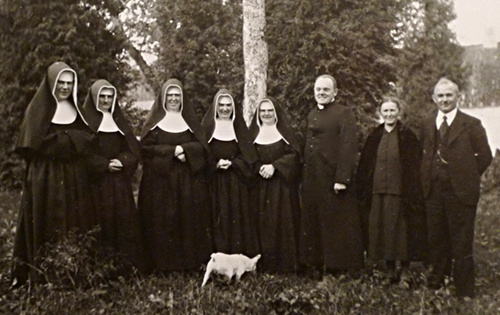
L2R: Srs. Berthilla Neguin, Kazimiera Milewska, Aurelia Wachowska, Leone Schettke, Meinolfa Falka, Fr. St. Wierzbica, Mr&Mrs Herzog from Nowogródek, Rajca, 1935 r.
After two years of relative stability, a radical change in perspective appeared: outbreak of the World War II, as a result of Hitler’s expansion politics. Nations, states, organizations and individuals surrendered to the war’s totalitarian dictatorship. A new religious family, one of the youngest in the Polish Church at that time (the total number of members was 64, including 27 novices and postulants), after five years of existence, together with the entire nation stood up to the general defense of the homeland. The Sisters organized discussion sessions about the situation for the local population, prepared bomb-shelters, and by themselves ran a drug-store supplied with medicines. To add to the drama, on September 17th, 1939, the Soviet army evaded Poland from the East. By decision of Russian commanders, the main house of the Sisters in Rajca was transformed into a hospital, and three Sisters were engaged to work there. Other Sisters were forced to leave the mother-house. Postulants and novices in the main returned to their family homes. Instead, the Professed Sisters at first separated, creating several unofficial groups: in Rajca, Nowogrodek, Vilnius and Plonka Koscielna. Contact between these groups was very difficult, and more than once outright impossible. The policy of the invaders (Germans from the West and Russians from the East at the same time) caused not only territorial disorganization, but also legal problems in the internal structure of the Polish Region of Pallottines. In October 1939 the superior of the Polish Region, Sr. Aurelia Wachowska, harried by circumstances, left for Plonka Koscielna. From this moment contact with her was cut off with the Sisters. Local superiors out of necessity exercised autonomous authority. Following the request of Sr. Aurelia Wachowska, the superior of the Sisters of Nazareth, Mother Fides, took care of the Sisters in Vilnius (now Lithuania).
Throughout the time of war, the Sisters launched out into different forms of help to their countrymen. They undertook work in the Vilnius Committee for Refugees, where they ran sewing work-rooms for Poles running away from the nazist front. Within the framework of the Main Protective Committee, they worked in shelters for children in Warsaw and Mszczonow, organized so-called folk kitchens. As nurses they supervised the ill in hospitals (also epidemiological), in health centeres and in private homes. In the regions of Nowogrodek and Vilnius sisters rendered health services, and in the measure of their possibilities also material aid to local partisans. Sisters also helped the discriminated Jewish population, giving shelter to the threatened in Rajca and Nowogrodek, and making it possible for them to escape to a safe place.
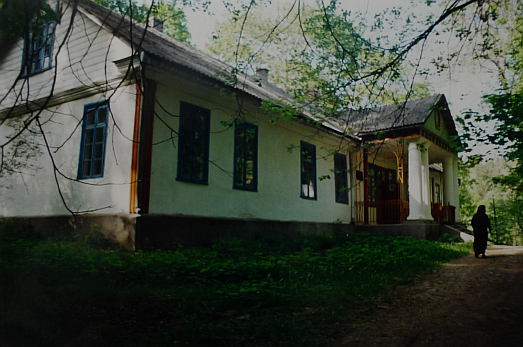
Our first house in Rajca; the wing where was the chapel – photo from 1993
After the liberation, separated Sisters sought their own communities, joined in greater teams, trying together to dissolve the dilemma of the new beginning, in new circumstances, practically from scratch, especially in the new political situation when the war ended with a new sort of dependency and slavery – this time from communism and the Soviet Union. In 1945 the entire evacuation of the Congregation took place from the eastern lands of Poland, which, following the Yalta pact, would now belong to the Soviet Union (up to 1989, the year of the Solidarity “uprising”; at present the territory of Belorussia). Sisters established houses in the northern part of the devastated country, mostly in Gdansk. The organization of houses was going on simultaneously with other activities for the people. Sometimes, however, it was necessary to undertake the activity earlier, before the possible establishment of a community. So it was in the case of the community in Gdansk. In the city still on fire, seized with an epidemic of typhoid, orphans and ill children wandered everywhere. The Sisters built a provisional barrack and lived there with the children. So establishes the initial card of history of the house which through 40 years was an abode of the Administration of Pallottines in Poland. What a coincidence: the convergence of the circumstance and social need which were a first-hand impulse to establishing Pallottine communities: the one in Rome in the year 1838, when the first community of Roman Pallottines was formed around orphan girls as the result of the epidemic of cholera in 1837 – and the other one in Gdansk in 1945.
In the year 1947, the Polish Region of the Congregation was raised to the rank of quasi-province. At that time the Pallottine Congregation in Poland counted 28 sisters, situated in five houses. The first superior of the quasi-province became Sr. Zygmunta Bielawa (the term of office: 1947–1962). In the following years and continuing numbers of vocations, new houses and communities in different parts of the country came into being. In the year 1968, on closing the term of office of second in turn to the higher superior, Sr. Elzbieta Hebel, the quasi-province possessed already 15 homes.
The year 1968 is a very significant date in the annals of the Polish Pallottines. The deliberating General Chapter of the missionary branch of Sisters of the Catholic Apostolate raised the Polish part of the Congregation to the status of a province, and the office of superior provincial was recommitted to Sister Zygmunta Bielawa, who held it until the year 1974.
A land-mark for the all Congregation was the transfer of the abode of the General Administration from Limburg to Rome in the autumn of the same year. Now, the return to our roots.
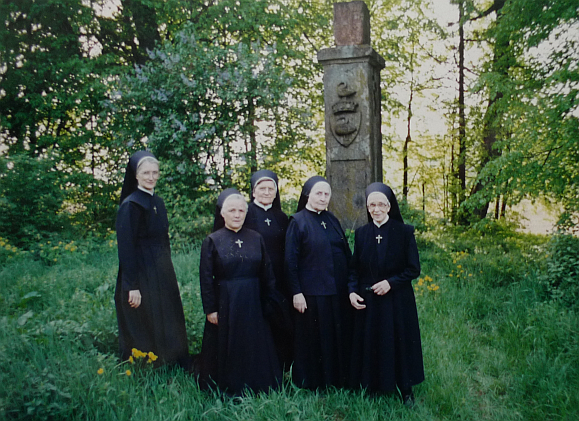
Sisters the Pioneers: (R-L) Sr. Elżbieta Hebel, Sr. Paula Buchwald and Sr. Zygmunta Bielawa, accompanied by Sr. Bogdana Cwalińska and Sr. Fides Misiewicz on visit to Rajca in 1993.
Throughout the following years the function of superior provincial was held by: Sr. Fides Misiewicz (1974-1986); Sr. Wladyslawa Sitarz (1986-1995); Sr. Anna Kot (1995-2001); Sr. Maria Swiatkowska (2001-2004); Sr. Blanka Slawinska (2004-2010); Sr. Bernadetta Turecka (2010-2015); Sr Mirosława Włodarczyk (2015-2018); Sr. Iwona Nadziejko (2018-). At present, the Polish Province numbers approx. 300 members within 27 communities in the country, and communities abroad: in Belorussia, Ukraine, Russia, France, Italy, Rwanda, Congo and Cameroon (in the nearest future the African Delegature will become a region).
By Sr. Mirosława Włodarczyk SAC
_____________________
*Sr. Aurelia Wachowska remained in Poland till 1958, died in Germany in 1969; Sr. Kazimiera Milewska stayed in Poland till her death in 1981.
Photos: Provincial Archives


